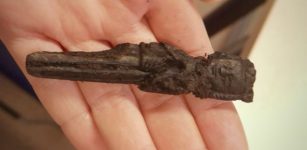51,000-Year-Old Bone Carving Shows Neanderthals Were Artistic Long Before Humans Arrived
Jan Bartek - AncientPages.com - A 51,000-year-old bone carving engraved with symbols offers evidence the Neanderthals were not as primitive as previously thought and it is time to change our understanding of our closest relatives.
The artifact discovered in a German cave could be proof the Neanderthals had their own artistic tradition before modern humans arrived on the scene.
The Neanderthals were resourceful and creative. Credit: Adobe Stock -Gorodenkoff
The archaeological site called Einhornhoehle, or "Unicorn Cave" where the bone was found was home to the Neanderthals tens of thousands of years ago.
Using radiocarbon dating, scientists were able to determine the bone is 51,000-year-old and predates the arrival of Homo sapiens in central Europe by some 10,000 years, according to the research published in the journal Nature Ecology and Evolution.
"The cultural influence of H. sapiens as the single explanatory factor for abstract cultural expressions in Neanderthals can no longer be sustained," the study says.
“The bone, from the foot of a rare extinct giant deer, is about half the size of a deck of playing cards (about 5.5 centimeters long, 4 centimeters wide) and three centimeters thick.
The giant deer bone has no practical use and is believed to be purely decorative. Credit: © V. Minkus/NLD
Six diagonal intersecting lines intentionally carved into it form a kind of chevron design that covers much of one surface,” the AFP reports.
"We are very convinced that communicates an idea, a story, something meaningful to a group,” Dirk Leder, one of the authors and a researcher at the Lower Saxony Office for Heritage Department of Archaeology, told AFP.
Examination of the ancient deer bone suggests the item is of no practical use and is a result of the Neanderthals’ creativity.
Instead, the geometric pattern itself constitutes the central element. The complex production process leading to the creation of the incisions, their systematic arrangement and the scarcity of giant deer north of the Alps, support the notion of an intentional act and of symbolic meaning," the study says.
Entrance to the Unicorn Cave. Credit: Unicorncave - CC BY-SA 4.0
According to scientists, the 51,000-year-old deer bone stands out as "one of the most complex cultural expressions in Neanderthals known so far".
Leder emphasizes “that unlike the art of Homo sapiens the various marked objects attributed to Neanderthals are not really comparable to each other, perhaps because their populations lived in smaller, more spread-out clusters.
"It seems to support the idea that within the population communicating with these things, the meaning of the symbols was not transmitted to the next generation or just died out," he said.
See also: More Archaeology News
But the fact that the new find predates Homo sapiens means Neanderthals might have left a more enduring legacy.
"The idea was always that the great Homo sapiens was giving intelligent ideas to other species," said Leder.
"In the past few years a handful of papers are pushing the idea that it could have been other way around," he said.
Written by Jan Bartek - AncientPages.com Staff Writer























